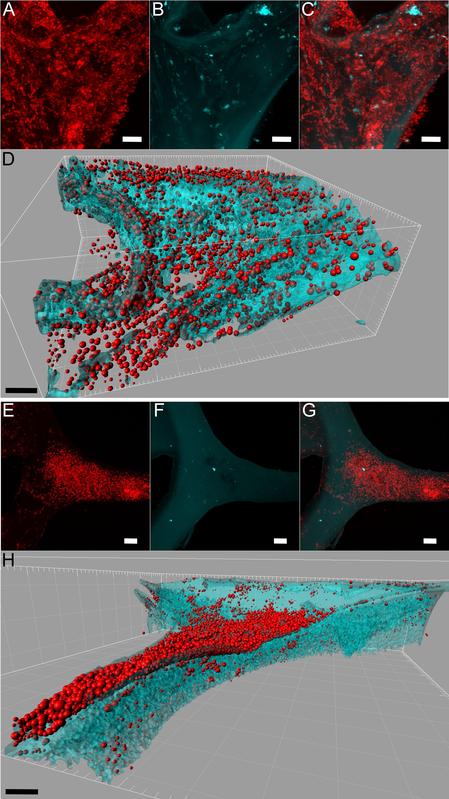The Kitchen Sponge – Breeding Ground for Germs

Analysis of bacteria in sponge sample. Maximum projections of confocal stacks, showing EUB338MIX–stained bacteria in red (A and E) and sponge autofluorescence in cyan (B and F) Scientific Reports
In Germany there are around 40 million private households. “If each has one or two kitchen sponges then the total number is around 40 to 80 million,” says Professor Dr. Markus Egert of Furtwangen University who headed up the study. “If you include institutional facilities, you are probably talking about more than 100 million in Germany.” One hundred million potential germ breeders.
The study was a cooperative project between Furtwangen University (HFU), the Justus Liebig University in Gießen and the Helmholtz Centre in Munich; HFU funded the project. The study has now been published in the prestigious scientific journal “Scientific Reports” which belongs to the Nature Publishing Group. (DOI:10.1038/s41598-017-06055-9 1, www.nature.com/scientificreports, Title: Microbiome analysis and confocal microscopy of used kitchen sponges reveal massive colonization by Acinetobacter, Moraxella and Chryseobacterium species).
The microbiologists put 14 used sponges from the Villingen-Schenningen area under the microscope. They found 362 different types of bacteria. “What surprised us was that five of the ten which we most commonly found, belong to the so-called risk group 2, which means they are potential pathogens,” explained Egert.
These are environmental and water bacteria, but also bacteria which are typical for the human skin. Particularly for people with a weak immune system such as patients and the elderly, bacteria such as Acinetobacter johnsonii, Moraxella osoloensis and Chryseobacterium hominis can lead to infections. The very commonly found Moraxella osloensis bacteria can also cause kitchen sponges to stink. Faecal bacteria and those which cause food poisoning or dysentery however, were scarcely detected.
However the real cause for concern is: in sponges which according to their users were regularly cleaned either in the microwave or through washing, showed considerably higher levels of potentially pathogenic bacteria. The scientists assume that the cleaning of the sponges can lead to a short-term decrease in the number of germs; obviously in the quickly regrowing communities however, the potentially pathogenic bacteria achieve an ever stronger domination, probably due to a higher stress tolerance.
Kitchen sponges are mainly made of foam material, such as polyurethane. Due to their multiple pores, the huge inner surface area offers microorganisms a lot of space to grow. “Sometimes the bacteria achieved a concentration of more than 5 times 1010 cells per cubic centimetre,” explained Egert. “Those are concentrations which one would normally only find in faecal samples.
And levels which should never be reached in a kitchen. These high concentrations can be explained by the optimal conditions the bacteria find in the sponge: besides the large surface area for growth, there are high levels of moisture and nutrients from food residue and dirt. The photographic and film material from the study is impressive proof of the bacterial contamination of the kitchen sponges and can thus be used as teaching material to raise awareness for kitchen sponges as microbial incubators in the household.
Problems can arise particularly in sensitive environments – in hospitals, retirement homes or in private houses, if patients with weak immune systems are nursed at home. Instead of frequent washing, for hygienic reasons it is better to throw kitchen sponges away regularly, approximately once a week. Incidentally, the researchers could not detect any microbial contamination in newly bought sponges.
Media Contact
More Information:
http://www.hs-furtwangen.deAll latest news from the category: Life Sciences and Chemistry
Articles and reports from the Life Sciences and chemistry area deal with applied and basic research into modern biology, chemistry and human medicine.
Valuable information can be found on a range of life sciences fields including bacteriology, biochemistry, bionics, bioinformatics, biophysics, biotechnology, genetics, geobotany, human biology, marine biology, microbiology, molecular biology, cellular biology, zoology, bioinorganic chemistry, microchemistry and environmental chemistry.
Newest articles

Properties of new materials for microchips
… can now be measured well. Reseachers of Delft University of Technology demonstrated measuring performance properties of ultrathin silicon membranes. Making ever smaller and more powerful chips requires new ultrathin…

Floating solar’s potential
… to support sustainable development by addressing climate, water, and energy goals holistically. A new study published this week in Nature Energy raises the potential for floating solar photovoltaics (FPV)…

Skyrmions move at record speeds
… a step towards the computing of the future. An international research team led by scientists from the CNRS1 has discovered that the magnetic nanobubbles2 known as skyrmions can be…





















